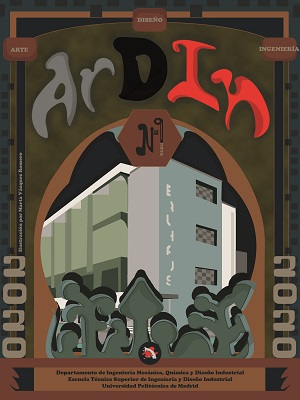La importancia del proceso en el diseño: el camino que te lleva a un lugar inesperado = The importance of process in design: the path that leads you to an unexpected place
DOI:
https://doi.org/10.20868/ardin.2020.9.4122Keywords:
arte, diseño, creatividad, proceso, inesperado, art, design, creativity, process, unexpectedAbstract
Los docentes de áreas relacionadas con el diseño se encuentran en una incesante búsqueda conceptual y metodológica, cuyo fin último es provocar que los estudiantes exploten su potencial creativo y lo dirijan hacia la generación de un determinado resultado final.
A partir de la relación que se establece entre procesos creativos en Arte y Diseño, se encuentra un tipo de proceso, que en el texto se denomina volumétrico, que abraza lo inesperado como parte fundamental en la evolución de una idea. El azar, la falta de control y la experiencia de vida son tomadas en cuenta de manera indivisible en aquellos procesos creativos en los que la serendipia suceda desde la curiosidad, la percepción libre y la supremacía de los hechos frente a la teoría.
Estos planteamientos se ilustran en este texto a partir de la obra de diversos autores cuyo resultado no viene predefinido por ellos. Con los títulos Cazadores de datos, Registro de lo sucedido y Que lo hagan otros, referentes como Eric Fisher (2010), Tim Knowles (2005) o Joan Foncuberta (2012) evidencian que la creación posee ese sentido multidimensional, en el que el suceder de la idea pone en marcha la materialización de ésta sin que necesariamente haya que perseguir un resultado final preconcebido.
Así, desde este espíritu didáctico, los autores de este texto proponen que, el profesional del mundo del diseño, cuyos límites de actuación cada vez están más desdibujados, sea capaz de desarrollar proyectos de alto potencial creativo generando procesos precisos y transparentes en su evolución y aprendizaje.
Abstract
Teachers in design areas are in a conceptual and methodological relentless search, whose aim is to trigger students’ creative potential and direct it towards the generation of a certain final result.
Based on the relationship established between creative processes in Art and Design, there is a type of process, which in the text is called volumetric, that embraces the unexpected as a fundamental part in the evolution of an idea. Chance, lack of control and life experiences are indivisible aspects considered in those creative processes in which serendipity is result of curiosity, free perception and the supremacy of facts against theory.
These approaches are illustrated in this text with the work of various authors whose results are not predefined. With titles as "Data hunters", "Registering what happened" and "Let others do it", examples by Eric Fisher (2010), Tim Knowles (2005) or Joan Foncuberta (2012) show that creation has that multidimensional sense , in which the completion of an idea starts without necessarily having to pursue a preconceived final result. From a didactic spirit, the authors of this text propose that any professional designer, whose limits of action are being blurred, must be able to face projects of high creative potential by generating precise and transparent processes in matters of development and learning.
Downloads
References
Coppo, J.A. (2012). Serendipia. Revista Veteterinaria, v.23 (I). 71-76. Recuperado de http://revistas.unne.edu.ar/index.php/vet/article/download/1825/1576
Cooke, L. (2011). Alighiero Boetti: Estrategia de juego. Madrid: MNCARS.
González-Andrío, G. (2016, 22 de septiembre). Toni Segarra: «Me temo que llegar arriba era más fácil hace unos años si teníastalento. Ahora cuesta algo más». Dircomfidencial. Recuperado de: https://dircomfidencial.com/marketing/entrevista-a-toni-segarra-co-fundador-y-director-creativo-de-scpf-20160922-0405/
Gonzalez, C., Rolando, E., García-Díaz, V., Pelayo, C., Cueva, J.M. (2019). A Review of Artificial Intelligence in the Internet of Things. IJIMAI. International Journal of Interactive Multimedia and Artificial Intelligence, vol.5, n.4, 9-20. DOI: http://dx.doi.org/10.9781/ijimai.2018.03.004
Infobae. (2011, 15 de noviembre). Cómo nació el proceso creativo de Apple. Infobae. Recuperado de https://www.infobae.com/2011/11/15/1038038-como-nacio-el-proceso-creativo-apple/
Jones, J. C. (1970). Design Methods. Londres: Architecture Design and Technology Press.
Marchetti, W. (1999). The Hunt and other writings. Vancouver: Morris and Helen Belkin Art Gallery.
Matesanz, V. (2014, 18 de junio). ¿Qué era la creatividad para Steve Jobs? Forbes. Recuperado de http://forbes.es/life/4370/que-era-la-creatividad-para-steve-jobs/
Mendiola, E. (2016). Conocimiento accidental o serendipia en las ciencias. En Barzola. M.V, y Mendoza, M. (Coords.). Creación y Producción e Diseño y Comunicación, 76 (pp. 74-76). Buenos Aires: Facultad de Diseño y Comunicación - Universidad de Palermo. Recuperado de https://fido.palermo.edu/servicios_dyc/publicacionesdc/vista detalle_articulo.php?id_libro=630&id_articulo=13188
Sennett, R. (2019). Construir y habitar. Barcelona: Anagrama.
Yepes, R. (1997). La persona como fuente de autenticidad. Actaphilosophica, v.6, fasc. 1. 83-100. Recuperado de http://www.actaphilosophica.it/sites/default/files/pdf/yepes_stork-19971.pdf
Downloads
Published
Issue
Section
License
ArDIn does not charge authors for processing or publishing an article and provides immediate Open Access to its content. All content is available free to the user or their institution. Users are permitted to read, download, copy, distribute, print, search or link to the full text of articles, or use them for any other lawful purpose, without prior permission from the publisher or author. This is in accordance with the BOAI definition of open access.
- Authors retain the copyright and grant to the journal the right to a Creative Commons attribution / Non-Commercial / Non-Derivative 4.0 International (CC BY NC ND) License that allows others to share the work with an acknowledgement of authorship and non-commercial use.
- Authors may separately establish additional agreements for the non-exclusive distribution of the version of the work published in the journal (for example, placing it in an institutional repository or publishing it in a book).
Unless otherwise indicated, all contents of the electronic edition are distributed under a Creative Commons license.













